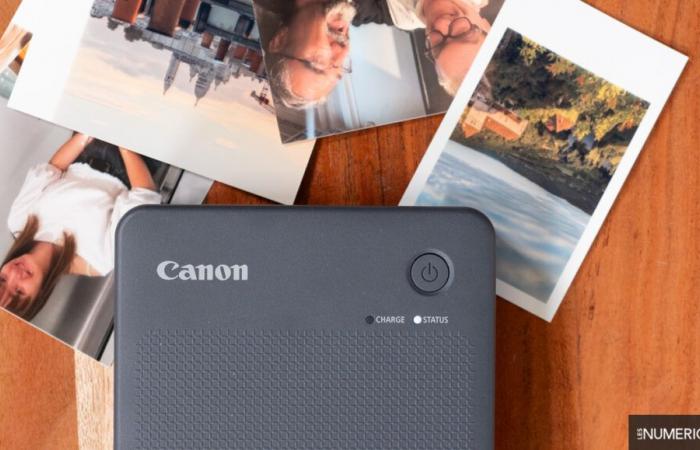Canon Selphy QX20, a small thermal sublimation printer.
© Renaud Labracherie / Les Numériques
We can never say it enough: photography is above all the sharing of emotion. We're not talking about yet another digital sharing on Instagram or WhatsApp. No, this is the sharing of a real photograph, a paper print. Photographs that line the fronts of refrigerators, decorate offices or decorate the walls of the house. Although most office inkjet printers can perfectly print images on photo paper, the implementation remains complicated (you have to buy specific paper) and the quality is not necessarily there.
A complete range
Canon is an important player in the printing sector, particularly in photography. The Japanese brand effectively masters laser and inkjet printing (imagePROGRAF Pro-1100), but also more confidential technologies such as ZINK (Zoemini), or even thermal sublimation with the Selphy CP1300 or the more recent Selphy QX10.
Younger sister of the latter, the Selphy QX20 completes the range of pocket photo printers, a model which has the uniqueness of printing in two credit card formats (XC-20L/XC-60L cartridge, 54 x 85 mm) or square (XS-20L cartridge, 72 x 85 mm).
Ergonomics
If the Canon Selphy QX20 falls into the category of nomadic printers, its thermal sublimation technology makes it a little more imposing than a Fujifilm instax mini Link 3 or HP Sprocket. It does not fit in a pocket, but its dimensions of 102 x 146 x 33 mm and its weight of 470 g (fully equipped) allow it to be easily transported in a bag.
Brick design
After a QX10 with rounded shapes, this QX sports a parallelepiped design, more sober and less singular, close to a brick. The interface remains extremely simple with a single button for powering on and two operating indicators. The paper is loaded from below, and to insert the print cartridge, you will have to lower the hatch on the side. Flexible, it will be handled without difficulty, perhaps with less risk of it breaking during handling. On the connector side, the only visible one is a USB-C format power socket. To print, you will need to connect the QX20 to your smartphone via wifi.
The ink ribbon fits into the side of the printer.
© Renaud Labracherie / Les Numériques
Simple and creative application
On the application side, Canon SELPHY Photo Layout is quick to learn and offers a wide range of options. You are able to choose to print a selection of images which you can also retouch (orientation, cropping, brightness, color saturation and application of different filters).
The Selphy Photo Layout app is simple, but enough to have fun.
© Screenshots / Les Numériques
Only available on smartphones (Android, iOS), the app also allows you to create assemblies of up to six images. You can also add decorative elements to personalize your prints and play with texts and/or borders. The choice is relatively wide in order to give a new tone to your photos. Finally, the user has the choice between printing with or without borders.
Be careful though, because the marginless mode does leave… a margin. Whether in square or rectangle format, the prints all have a margin of 1.5 cm to take the photo or write a little note. A complete marginless mode is impossible.
The application allows you to enrich the photos or make assemblies.
© Screenshots / Les Numériques
One of the arguments of the QX20 remains the possibility of printing two photo formats, but again, be careful: you can switch from one format to another without waiting for the cartridge to run out, but then you have to change to both the paper and the printing ribbon. Going from square to rectangle therefore requires a little rigor so as not to mix consumables and the whole thing seems quite fragile.
Finally, we regret that the charger cannot accommodate the 20 sheets that can be printed using the ribbon. You will need to recharge the Canon Selphy QX20 from the first 10 images output.
You can load square or credit card size paper in packs of 10 sheets only.
© Renaud Labracherie / Les Numériques
First impressions
Once your image or creation is selected, we start printing. It takes around 10 seconds for data transmission over WiFi (Google Pixel 9 Pro XL), then 45 seconds for printing which is done in four passes (three colored and a finishing coat).
The print is much noisier than an Instax print with a peak measured at 58 dB (A). In a festive atmosphere, this will not really be a problem.
Canon offers printing on sticker paper, which is a great idea. Removing the film is not easy, but once you get the hang of it, the operation is done quickly and you can paste your photos on different supports as you wish.
The Selphy QX20 has a USB-C connector for charging.
© Renaud Labracherie / Les Numériques

Image quality
The three phases of dye sublimation printing: yellow, magenta and cyan.
© Renaud Labracherie / Les Numériques
Thermal sublimation printing technology allows you to obtain quality prints, close to what you get from a local photographer (who can very well use a printer equipped with this technology). The prints are distinguished by a good level of precision in details and an excellent feeling of sharpness.
Facing Instax
We made a print of an identical shot with the Instax mini Evo and the Selphy QX20. Without real surprise, the Instax print appears a little duller, less contrasted and with less dynamic. In terms of precision, the thermal print is finer, but the differences are ultimately not very visible on the small credit card format, unless you pay particular attention. However, they can easily be highlighted by scanning the photos at 600 dpi.
Instax mino Evo on the left; Canon Selphy QX20 on the right.
© Renaud Labracherie / Les Numériques
Flattering colorimetry, but not very faithful
Color rendering turns out to be imprecise, with our measurements indicating an average delta E of 7.5. We are quite far from impeccable fidelity, but you must keep in mind that an Instax print has a delta E of 9.4 (Fujifilm Instax mini Link 3). For the record, so that the human eye does not detect colorimetric variations, the delta E must be less than 3. Here again, the difference with an Instax print is not obvious on landscapes or portraits.
Measurements of colorimetric drifts of the Canon Selphy QX20.
© Les Numériques







